In the educational landscape, extended reality tools have an incredible opportunity to enlighten and engage students in a variety of spaces. Already, countless universities and businesses have embraced VR, AR, and MR as tools for better training.
With the correct blend of immersive technologies, it’s easier for business leaders and educators alike to deliver information to students in a way capable of boosting recall and performance. GE Healthcare, a market-leading company in the construction of powerful medical equipment, discovered this first-hand when it decided to implement Microsoft HoloLens technology.
Today, we’re taking a closer look at how GE Healthcare implemented mixed reality components into its training strategies, to empower current and future employees.
Exploring New Training Solutions for Experts
GE Healthcare is a company committed to creating innovative and sophisticated medical equipment, including CT and MRI scanners for modern diagnostics. Used by healthcare facilities worldwide, these complex devices require highly trained engineers to perform regular repair and maintenance functions. This means GE Healthcare needs to provide the right training solutions to experts across the globe, to keep its devices running.
For some time, GE Healthcare had been experimenting with new technologies and training models to boost employee efficiency and performance. According to Hui Gao, the Head of Technical Operation for the GE Healthcare brand, training is critical to ensuring the competency of engineers. However, traditional methods of education have had some limitations in the past.
Ready to embrace something new for their educational needs, GE Healthcare turned to the Microsoft Mixed Reality Partner Program, where it found support from Adjacentech Corporation. The expert on MR development supported GE Healthcare in creating a new training approach, capable of empowering employees quickly and effectively.
GE Healthcare and Adjacentech worked on a re-imagined version of their training strategy using the Microsoft HoloLens 2. This involved creating simulated training models capable of providing engineers with accurate step-by-step guidance, holographic 3D visualizations and more, on top of real-world objects like medical equipment. This ensured students could gain a better understanding of maintenance procedures for complex machines.
Building a Mixed Reality Toolkit
Adjacentech and GE Healthcare wanted to build a training solution capable of addressing the common challenges engineers and maintenance professionals were experiencing every day. For instance, one of GE’s tools, the Revolution CT Scanner, features 52 modules all receiving and leveraging an attenuated X-ray beam. These modules are delicate and expensive, easily broken without the right training and guidance.
The Voyager MRI system, on the other hand, has a series of intricate wires throughout, linked to a selection of servers in an IT center. It can be difficult to understand at a glance how the different components and pieces link together.
To introduce the new method of MR training to GE Healthcare, Adjacentech demonstrated the abilities of the HoloLens 2 from Microsoft, highlighting how mixed reality could connect the physical and digital worlds for better guidance. With tools like Azure Remote Rendering, Spatial anchors, and object anchors, developers were able to create impressive 3D visualisations.
For instance, Azure Spatial Anchors allowed GE Healthcare to make virtual content appear in the real world for technicians. This allows engineers and experts to see step-by-step guidance next to a medical device every time they use their HoloLens 2 headset. Spatial anchors also allow for the creation of multi-user experiences, so users in the same space could see the same visualizations, regardless of where they were standing.
Azure Object Anchors, on the other hand, allowed the hardware in the HoloLens 2 to detect specific objects in the room, then render 3D virtual content via the Azure Remote Rendering system. For instance, this could allow the company to lock specific virtual content to pieces of medical equipment. Azure Remote Rendering uses cloud power to render a range of complex objects in high-fidelity via the HoloLens 2 headset.
Azure Cognitive and AI services even allowed GE Healthcare to leverage AI-based narration to guide trainees throughout the educational process.
Implementing New Training Strategies
Following a successful pilot of the Mixed Reality technology, GE Healthcare proceeded to implement the technology through two specific use cases. The first step was to implement Voyager MRI cabinet training. With the HoloLens 2, GE Healthcare can embed holographic schematics and connection diagrams into the cabinet. This allows trainees to track important information while actually interacting with the cabinet itself.
The second step involved training team members on detector module replacement within the Revolution CT scanner. Using a high-fidelity holographic model in the HoloLens 2, engineers can now observe and learn the steps involved in module replacement anywhere, reducing the risk of damage to sensitive components.
Already, GE Healthcare has experienced a range of significant benefits as a result of deploying its mixed reality solutions. In the two use cases mentioned above, trainees save around four hours each on the training process. Reduced training hours means specialists can gain more hands-on time in the lab to practice their skills, improving their knowledge of key skills.
The use of the HoloLens solutions has also reduced the risk of damage to around $20 million in medical equipment throughout the Chinese workplace.
Looking Ahead with MR Training
The significant benefits achieved by GE Healthcare with Microsoft HoloLens and Adjacentech has prompted the company to look even further into XR for educational opportunities going forward. GE believes it has only just scratched the surface when it comes to the potential of mixed reality. According to the Instructor Manager for the team, David Xiao, MR has a lot of broad uses for the company and other industries in the future.
MRI Instructor for GE Healthcare, Wei Meng said they believe mixed reality may be critical to enhancing traditional training methods, and providing students with a better way to grasp the complex technology. With mixed reality, it’s possible to create an entirely interactive and fully immersive learning experience for every student.







